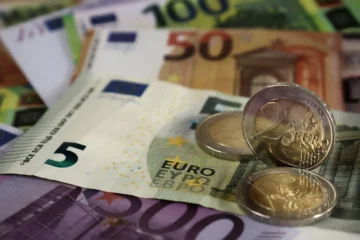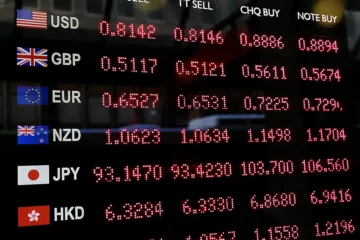US
S&P closed the week at 2,834, up 0.7% during the day and marks its best performing quarter in the last 10 years being up 14% from December. On Friday, DJIA closed 0.8% higher at 25,929. The Nasdaq Composite climbed 0.8% to close at 7,729. 10-year Treasuries ended the week at around 2.406%. US stock market ended higher on Friday as investors expect progress in US-China trade dispute. The US quarterly earnings season starts at the beginning of April.
Dollar index DXY closed the week at 97.21 having a 0.00% change. The volatility index VIX fell on Friday by 4.99% to the level of 13.71. Oil prices continued to rise. Crude oil WTI went up 2.05% this week, reaching the price level of $60.18. Gold (GCJ9) ends the week at $1,290.80.
The week in the US began with big price movements on streaming providers, a reaction to Apple announcing its new streaming service and credit card. On Tuesday markets have quickly retracted due to falling US 10-year Treasuries, which have reached their near 15 month low yield on Thursday at 2.389%. Market data showed a yield curve inversion as the 10-year Treasury yield has fallen below the 3-month note yield. This is often interpreted as a signal of recession happening within the next 12-24 months. The US published its fourth quarter GDP growth, coming in at 2.2%, marking a slowdown compared to 2017 and significantly below the previously estimated 2.6% level. On Friday, last trading day of the quarter, previous news have been offset by hopes of progress in the long lasting tariff dispute and markets have rallied up, with Lyft being the star of the day, gaining +8.2% on its IPO price.
UK
PM May and her government lost control of the order of the house this Wednesday. They tabled a first round indicative votes on Brexit alternatives ranging from a no-deal Brexit to a second referendum. All 8 of the alternatives which the house speaker Bercow passed to election got rejected by MPs on Wednesday March 27th. A second round of indicative votes is set for April 1st which MPs hope brings clarity into the Brexit procedure. Together with Mays withdrawal agreement being rejected for the third time on Friday the 29th the deadline for Brexit is now still set for the 12th of April.
The continued uncertainty over Brexit reflected in the British pound. GBP-USD was down over the week from 1.325 to 1.3042 reflecting a 1.16% drop. The BP volatility index BPVIX spiked to a 4 month high at 15.33 on Thursday. As a comparative value the Euro volatility, EUVIX, closed at 5.95.
Similarly as investors went for safer assets the yield on 10-year gilts were slightly down to 0.992%, dropping 3 basis points over the week.
The main equity index for the UK, the FTSE 100 had a strong start to the week, dipping after both votes but ending the week positively on a 0.99 % increase to 7297.19 from 7176.99.
Europe
EU European equity markets ended the last trading day of the quarter mostly green. DAX was up 1.42% to 11,526 this week. CAC 40 ended the week 1.52% higher at 5,350. In Italy, FTSE MIB rose by 0.98% to 21,286. Euro Stoxx 50 grew by 1.39% this week to 3,351. EU markets moved up after UK’s rejected Brexit vote as well as ECB’s announcement of implementing strategies that would offset the effect of negative interest rates on banks deposits, which has sent most of the European banks stocks up.
The EURUSD was roughly flat on the last day of the week closing at $1.1215. The yield on the 10-year German bund fell deeper into negative territory, to -0.069%, after the ECB said that it could further delay any plans to raise interest rates if the European economy continues to deteriorate. Italian 10-year bonds end the week slightly higher, at 2.489%, but it’s very unlikely it will make up for its 25 bp loss over the last month.
The rate of unemployment in Germany fell this month to 4.9 per cent from 5.0 per cent in February marking historically lowest rate since German reunification in 1990. At the same time its share of unfilled job positions grew in the final quarter of last year especially in the services sector, showing struggles in recruiting new workers.
Next week, on top of continuation of Brexit discussion, investors await data publication on EU consumer confidence and further information on ECB’s policies regarding banks.
RoW
Japan’s Nikkei notched up slightly over the week closing at 21,205.81 up 0.6% from 21,110. Hong Kong’s Hang Seng HIS closed at 29,051.36 up 0.96% over the week from 28,591.50. Similarly, China Shanghai Composite SHCOMP is up 3.2% to 390.76 as on Friday US Trade representative Robert Lighthizer, US Treasury secretary Steven Mnuchin and Chinese Vice Premier Liu He concluded a lighting fast round of trade talks in Beijing. The pressure on trade talks is growing in anticipation of the meeting between President Trump and Xi Jinping in the beginning of April. China granted regulatory approvals for two investment banks, Nomura and JP Morgan, for majority-controlled brokerages. Despite the timing of the announcement Chinas securities regulator stated it had nothing to do with the talks.
One reason for concern this week was again the movement of the Turkish lira which was following similar patterns of last summers’ stark inflation within the country. Data show that this march turkey burned through $10bn of foreign currency reserves representing 29% drop in its reserves trying to keep the lira stable throughout march. This data sent the lira down 5%. To stop further negative speculation banks were instructed not to lend lira to foreign banks anymore. On Thursday, the offshore overnight swap rate rose to as much as 1200.
New Zealand’s Central Bank hinted at possible rate cuts in the near future in a mix of increased uncertainty about the economics health of the world economy, particularly with its main trading partners: Australia, China and Europe. This send 10 year bond yields to record lows of 1.74%. A ripple effect was seen in the bonds market throughout the world.
Australia’s S&P/ASX 200 closed at 6,180.70 being up 0.73% over the week. The South Korean index KOSPI was down -0.67% over the week closing at 2,140.67. South Koreas trade balanced is scheduled to publish April 1st next week with predictions at $6.63bn.



0 Comments